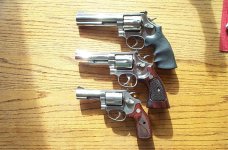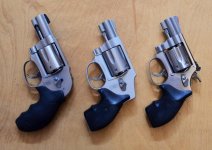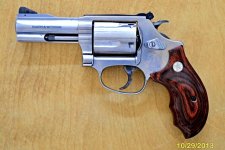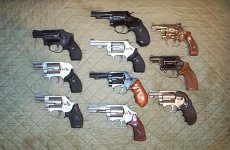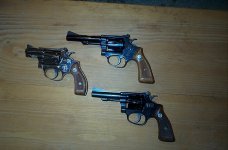I would like to find a nice J-frame revolver to go with my K,L, and N. The problem is that unless I have the revolver in my hands, how do I know it is a J-frame? Specifically, looking at the revolvers on online auction sites, unless the seller specifies the frame size (most don't), how do I know? Is there a good list showing what frame size specific models are? Or, more to the point, which models are J-frames?
You are using an out of date browser. It may not display this or other websites correctly.
You should upgrade or use an alternative browser.
You should upgrade or use an alternative browser.
Which models are J-Frames?
- Thread starter daveboy
- Start date
Rubone
Member
cgt4570
SWCA Member
If it was made after around 1958, it will have a model number. Before that, it will have a specific name that tells you it's a J frame (or the earlier similar i frame). Here are a few off the top of my head:
Model 30, 31, 32, 33, 34, 36, 37, 38, 40, 50, 51, and their stainless versions beginning with a 6, or the Airlight versions beginning with a 3.
This should get you started...
Model 30, 31, 32, 33, 34, 36, 37, 38, 40, 50, 51, and their stainless versions beginning with a 6, or the Airlight versions beginning with a 3.
This should get you started...
413Maxwedge
Member
- Joined
- Nov 19, 2023
- Messages
- 200
- Reaction score
- 337
Go on S&W website under products > Revolvers > J-frame and look at all the current offerings. This will give you a good visual starting point.
Last edited:
I didn't spend any time looking this up, but you missed the Model 35 and the Model 49.Model 30, 31, 32, 33, 34, 36, 37, 38, 40, 50, 51
Incidentally, the Model 34 .22/32 Kit Gun and the Model 35 .22/32 Target models became J frames with the -1 revision in each case. Originally, they were built on the I frame (consistent with your mention of the I frame units).
The Models 43 and 51 Kit Guns were always J frames. So were all the small frames chambered for the .38 Special.
THE PILGRIM
Member
Incidentally, the Model 34 .22/32 Kit Gun and the Model 35 .22/32 Target models became J frames with the -1 revision in each case. Originally, they were built on the I frame (consistent with your mention of the I frame units).
The Models 43 and 51 Kit Guns were always J frames. So were all the small frames chambered for the .38 Special.
Additionally, the Model 30, 31, and 32 were not J frames until the -1 revisions.
To keep things simple, look for a cylinder with only 5 charge holes, chambered for .38 Special.
ajgunner
Member
- Joined
- Jun 28, 2007
- Messages
- 27,660
- Reaction score
- 21,269
Keeping the model numbers above in mind and looking at images, and handling a few J frames, should get you familiar with them fairly quickly.
If you don’t want to learn the model numbers, one shortcut is to look for a 5-shot 38 special. If it meets both these criteria, it’s a J-frame.
This is gold!
It is good, but keep in mind it is not exhaustive. There are a bunch of J frame models that are not on that chart. It appears to be limited to models chambered for the .38 Special and .357 Magnum.
THE PILGRIM
Member
Rubone
Member
I don't think I mentioned it in my initial post, but actually .38 Special J-Models are what I was interested in. So, the chart, although incomplete, is exactly what I needed.It is good, but keep in mind it is not exhaustive. There are a bunch of J frame models that are not on that chart. It appears to be limited to models chambered for the .38 Special and .357 Magnum.
You are on a slippery slope, I see an X frame, I frame , M frame, then things go down hill faster. Good luck, fasten your seat belt.
Bag-o-worms!
Sir, you have opened a large bag of worms. There is a bunch of information in all of the above posts to your thread! Most of the J frame guns are decedents of the I frame guns which were introduced before the model numbering system was introduced. One model that is totally different than any of the others is the Chief's Special (later mod 36). It started life as an I/J frame. S&W wanted to chamber a smaller frame gun in the 38 S&W Special cartridge. They started with a Terrier (later mod 32) which was chamber in the 38 S&W. This cartridge is shorter and bigger in dia. than the 38 S&W Special. S&W made the cylinder longer, the frame window longer , but retained the grip frame and trigger guard of the I frame. We call these guns the "Baby Chief's Special"! Basically, a two-digit model number in the 30s with a -1 stamping(not mod39) is a J frame! However, the 36-1 is the designation for a 3" Heavy Barrel Chief's Special. More J frame model numbers are 40, 42, 43, 50, 51, 60, and later the SS guns with 3 digit model numbers starting with a 6xx and into the modern guns! ! ! Sorry this post became so long!
jcelect
Sir, you have opened a large bag of worms. There is a bunch of information in all of the above posts to your thread! Most of the J frame guns are decedents of the I frame guns which were introduced before the model numbering system was introduced. One model that is totally different than any of the others is the Chief's Special (later mod 36). It started life as an I/J frame. S&W wanted to chamber a smaller frame gun in the 38 S&W Special cartridge. They started with a Terrier (later mod 32) which was chamber in the 38 S&W. This cartridge is shorter and bigger in dia. than the 38 S&W Special. S&W made the cylinder longer, the frame window longer , but retained the grip frame and trigger guard of the I frame. We call these guns the "Baby Chief's Special"! Basically, a two-digit model number in the 30s with a -1 stamping(not mod39) is a J frame! However, the 36-1 is the designation for a 3" Heavy Barrel Chief's Special. More J frame model numbers are 40, 42, 43, 50, 51, 60, and later the SS guns with 3 digit model numbers starting with a 6xx and into the modern guns! ! ! Sorry this post became so long!
jcelect
Similar threads
- Replies
- 7
- Views
- 235
- Replies
- 5
- Views
- 436

